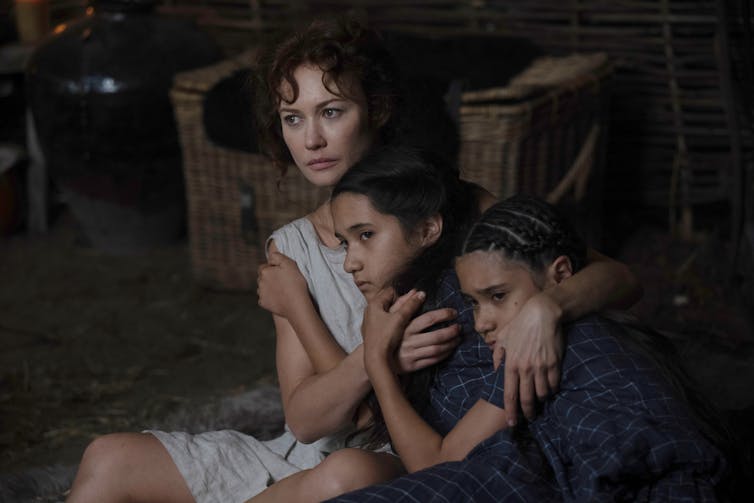Warning: this review contains some spoilers for Boudica: Queen of War.
Boudica: Queen of War is a lively and violent retelling of the ancient British queen’s story. Written and directed by Jessie V. Johnson, the film draws deeply upon Tacitus’ account of Boudica’s rebellion while also adopting Cassius Dio’s description of Boudica’s appearance and dress. Tacitus was a Roman author writing in the late first century AD, while Dio was a Greek author writing well over a century after the events.
Prasutagus (Clive Standen) is the leader of a peaceful people, the Iceni, who live in East Anglia (now in England) and want to avoid conflict with Rome. Content to live at peace on the borders of the new province, Prasutagus and his wife Boudica (Olga Kurylenko) even employ a Roman tutor to teach Latin to their daughters.
Early in the film, Boudica visits a Roman city apparently quite close to where she is living and dresses as a Roman lady. Boudica has been portrayed in many other accounts (such as Miranda Aldhouse-Green’s Boudica Britannia) as instinctively anti-Roman, so the depiction her pro-Roman family at the start of this film provides an interesting contrast.
The Britons are not all peaceful, however. The Iceni’s neighbours, the Trinovantes, want revenge on the Romans for overthrowing their oppidum (town) and building the Roman colony at Camulodunum (now Colchester). The film takes on board an idea emphasised in recent academic accounts that the ancient peoples of Britain were not united in their actions and that resistance to Rome was piecemeal.
Johnson’s film addresses some of the complex identities of the ancient peoples of Britain and their variable approaches to contact with and conquest by Rome, but with some confusion over the ethnicity of those involved in the action.
For example, Boudica’s followers in her rebellion in this film include “Saxons”, led by a warrior called Wolfgar (Peter Franzén). The Saxons did not arrive in Britain until centuries after Boudica, so they couldn’t have fought against Romans in first-century AD Britain. Films always need to be given some leeway.

The Scottish “Celts” are also deeply involved in the action and appear to be the same people referred to in the film as “northern Britons”. The term “Celt” has sometimes been erroneously used to suggest that the population of Iron Age Britain formed a unified whole.
Depictions of the Britons and Romans
The Romans in Britain, by contrast to the British, are depicted as highly aggressive and deceitful. Catus Decianus (Nick Moran), the provincial procurator, arranges the ambushing and killing of Boudica’s peaceful and loyal husband.

Boudica herself is flogged and dispossessed of her territories, while the Romans kill her two young daughters. This is unclear until some way through the film, since the ghostly forms of the young girls appear in subsequent actions to advise Boudica on her campaign.
In rebellion, Boudica abandons her Roman apparel and dresses in a long cloak with a torc (stiff gold necklace) around her neck. This costume choice draws on Cassius Dio’s description of her, which is the only detailed account of the appearance of an ancient Briton in the classical texts.
The Britons in the film are dressed in cloaks and trousers and do not fight naked (which I am sure is correct, though classical accounts of barbarians often emphasised their nakedness). And, of course, as always, this Boudica has red hair – another detail drawn from Dio’s description. She is also given a bronze sword handed down from a warrior ancestor.

A magical touch
Boudica is challenged for her role as the war leader of the Britons by Wolfgar, who seizes this sword, bends it in two and throws it into a lake which is dangerous to swimmers. This ineffectual nature of this Bronze Age weapon, according to Wolfgar, symbolises Boudica’s unsuitability to lead the rebellion.
Jumping into the lake, Boudica retrieves her sword – remarkably restored to pristine condition – and amply demonstrates its magical properties with a straw dummy. The director seems to have added elements of the medieval legend of Arthur and Excalibur to his tale of Boudica, but I think that there may be some other inspirations.

This sword reminds me of the ancient weapon drawn upon by Manda Scott in the first of her excellent Boudica novels, Dreaming the Eagle (2003). I wonder if Scott, in turn, was influenced by the Bronze Age palstave (axe) found in the grave of a late Iron Age king at Lexden (Colchester).
Not all the Romans are depicted as horrid. Emperor Nero (Harry Kirton), who resides in the city of Rome, is a troubled figure who wants to be a musician and seems to abhor violence.
Olga Kurylenko plays a convincing Boudica, transformed from a loving mother into a violent warrior by the events of war.
I found the complex issues explored by the film interesting. I particularly appreciated the way the idea that Britons could change allegiance was used. We cannot assume that Boudica was instinctively deeply anti-Roman. As Tacitus – and Johnson’s film – indicates, she was probably driven to violent action by Roman aggression.

Looking for something good? Cut through the noise with a carefully curated selection of the latest releases, live events and exhibitions, straight to your inbox every fortnight, on Fridays. Sign up here.

